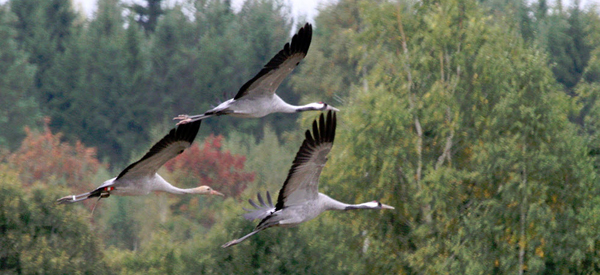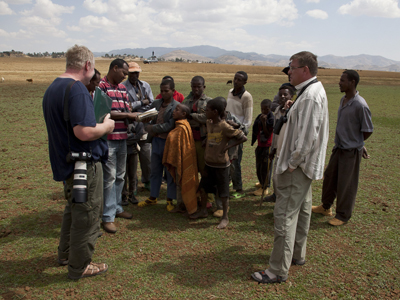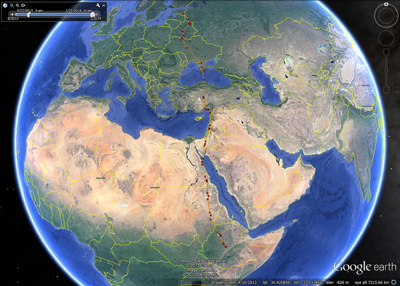 Researchers from the Estonian University of Life Sciences banded a juvenile Eurasian Cane in Estonia last summer (left). Their goal? To track the young crane on its first autumn migration and study the crane’s behavior and habitats used both during migration and on its wintering grounds. Learn what the researchers discovered below. Photo by Aivar Leito | |
| By Dr. Aivar Leito, Senior researcher, Estonian University of Life Sciences On July 8, 2013, a young Eurasian Crane named “Ahja 4” was banded and tagged with a satellite transmitter (22 g solar powered leg-band Argos/GPS MTI PTT-100) near Ahja village, Estonia close to its nest site. After banding, Ahja 4 spent its pre-fledging period near its home area within a few kilometers from the nest site. After fledging, Ahja 4 and its family joined the nearest flock of cranes roosting in a raised bog flooded for peat extraction at Meelva, approximately18 km from the nest site. The crane family fed mostly in cereal fields and cultivated grasslands around the Meelva Bog. Ahja 4 began migration on the morning of September 22 and arrived at its wintering location approximately 5,900 km south in Ethiopia on November 20 (see side bar to learn more about the migration). This wintering site is the southernmost documented wintering location of a satellite-tracked Eurasian Crane. A special expedition from the Estonian University of Life Sciences, in cooperation with Estonian national TV, visited the wintering area of Ahja 4 at Sululta close to Addis Ababa, Ethiopia between January, 16-26, 2014. The main scientific goal of the expedition was to study the home range, habitat use and behavior of a satellite-tracked crane on the basis of GPS locations. In total, 236 different locations visited by Ahja 4 were described. The crane family fed mainly in agricultural fields (barley, oat, peas, and other crops) and roosted on the river floodplain together with many other waterbirds. According to our counts and information from local people, the size of the crane flock where Ahja 4`s family roosted was ~2,000 birds.
Local communities at Sululta, Ethiopia learn about birds using a field bird guide. Estonian University of Life Sciences Geography Professor Kalev Sepp (left) and Ornithologist Leho Luigujõe (right). Photo by Urmas Sellis The most important characteristics described for each location were landscape, soil and habitat types, vegetation type, dominant plant species, agricultural land type, cultivated crop, wetness, distance from the nearest houses and roads, flock size, interactions among Ahja 4’s family , other bird and animal species near the family, and disturbances. Almost 10,000 photos of habitats, cranes, and other birds and animals, as well as of human activities, were taken, and over ten hours of video footage were taken by professional camera crews. The team consisted of Kalev Sepp (geography professor), Leho Luigujõe (ornithologist), Urmas Sellis (ornithologist), Kristo Elias (ETV manager), and Kristjan Jung (camera man). A local botanist Professor Abdella Gure and ornithologist Girma Mengesha Debsu, PhD also took part in this field work. The expedition was financed by the Estonian University of Life Sciences, Estonian National TV, and personal funds. | Over two months, Estonian researchers tracked the banded Eurasian Crane, Ahja 4, as it completed it’s first autumn migration between Ahja, Estonia and Addis Ababa, Ethiopia (see details on the crane’s journey below and click on the map to enlarge the image). Map by Aivar Leito September 22: Migration begins from Ahja, Estonia September 24: Arrives in Vitebsk area in northern Belarus September 29: Continues to south of Minsk in central Belarus October 16: Flies to southern Belarus very close to Ukrainian border October 19: Leaves Belarus and continues south, roosting overnight in central Ukraine, Crimea, and central and southeastern Turkey October 23: Arrives at the Hula Valley in northern Israel November 10: Leaves the Hula Valley and continues south, with short overnight roosting on the Sinai Peninsula, at Safaga on the Red Sea western coastal uplands, and Kassala River valley in eastern Sudan November 15: Arrives at Tana Lake in northern Ethiopia November 16: Moves to the east coast of the lake November 19: Continues journey to Sululta wintering area and arrives midday on November 20. Click here to follow the migration of Ahja 4 and other satellite-tracked cranes, storks and eagles from Estonia. For permission to use photos on the tracking website, please contact Urmas Sellis or the photographer listed in the photo caption. |


